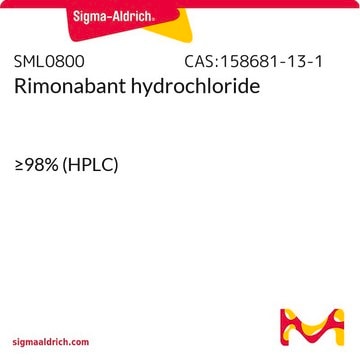SML1899
SR144528
≥98% (HPLC)
Sinónimos:
5-(4-Chloro-3-methylphenyl)-1-[(4-methylphenyl)methyl]-N-[(1S,2S,4R)-1,3,3-trimethylbicyclo[2.2.1]hept-2-yl]-1H-pyrazole-3-carboxamide, SR-144528
About This Item
Productos recomendados
Nivel de calidad
Análisis
≥98% (HPLC)
formulario
powder
color
white to beige
solubilidad
DMSO: 10 mg/mL, clear
temp. de almacenamiento
−20°C
cadena SMILES
C[C@]12[C@H](NC(C3=NN(CC4=CC=C(C)C=C4)C(C5=CC=C(Cl)C(C)=C5)=C3)=O)C(C)(C)[C@@H](C2)CC1
InChI
1S/C29H34ClN3O/c1-18-6-8-20(9-7-18)17-33-25(21-10-11-23(30)19(2)14-21)15-24(32-33)26(34)31-27-28(3,4)22-12-13-29(27,5)16-22/h6-11,14-15,22,27H,12-13,16-17H2,1-5H3,(H,31,34)/t22-,27-,29+/m1/s1
Clave InChI
SUGVYNSRNKFXQM-XRHWURSXSA-N
Aplicación
- to study its blocking effect on the anti-dyskinetic functionality of HU-308
- to study its effects on spontaneous excitatory postsynaptic currents (sEPSCs) from the globus pallidus neurons
- to analyze its effect on the gastric emptying in rats
Acciones bioquímicas o fisiológicas
Código de clase de almacenamiento
11 - Combustible Solids
Clase de riesgo para el agua (WGK)
WGK 3
Certificados de análisis (COA)
Busque Certificados de análisis (COA) introduciendo el número de lote del producto. Los números de lote se encuentran en la etiqueta del producto después de las palabras «Lot» o «Batch»
¿Ya tiene este producto?
Encuentre la documentación para los productos que ha comprado recientemente en la Biblioteca de documentos.
Los clientes también vieron
Nuestro equipo de científicos tiene experiencia en todas las áreas de investigación: Ciencias de la vida, Ciencia de los materiales, Síntesis química, Cromatografía, Analítica y muchas otras.
Póngase en contacto con el Servicio técnico











